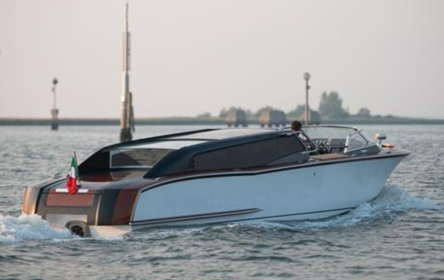Nuvolari Lenard Designs Hybrid Water Taxi
The Italian design firm Nuvolari Lenard recently finished a water taxi for the city of Venice. It uses a hybrid diesel-electric propulsion system and can seat up to 14 passengers. Named Thunder, the prototype was built at Cantieri Vizianello in Venice. The yard developed the mechanical and electrical coupler for the hybrid propulsion system.
Extensive Testing
The prototype vessel basically went through a year-long sea trial and was approved by all classification bodies, according to International Boating Industry. The 9.2-meter (30.18’) craft is now a “marketable product.”
“We hope that this progressive model for transportation in the city will change the mindset of the historically conservative transport companies in Venice, said Carlo Nuvolari in a statement. He co-owns the Italian design firm with partner Dan Lenard.
Nuvolari and Lenard are both Venetians and they feel strongly about minimizing impact to the city and its waterways through air and noise pollution and physical erosion.
Practical Propulsion
During the 2019 Venice Boat Show, Nuvolari Lenard organized a forum to discuss potential designs for a hybrid luxury water taxi. Diesel electric was deemed the most efficient solution. Nuvolari explained that short battery life is a common hurdle for “green” propulsion systems but because the taxi makes longer trips across open water to the airport and other destinations, the diesel engine can be used to charge the batteries.
Thunder was designed with deference to Venice’s history. The boat was built with a mix of traditional wooden materials and modern composites. Nuvolari Lenard has recently received a request to build a limousine tender for a superyacht on the same hull.
Nuvolari also said that the firm is in discussion with an Asian car manufacturer about using a hydrogen fuel-cell propulsion system, similar what’s being used in the aerospace industry. He explained that the limitations on storage of hydrogen on vehicles and vessels will require extensive testing before the technology can become a reality, but added that round-table discussions are taking place.

